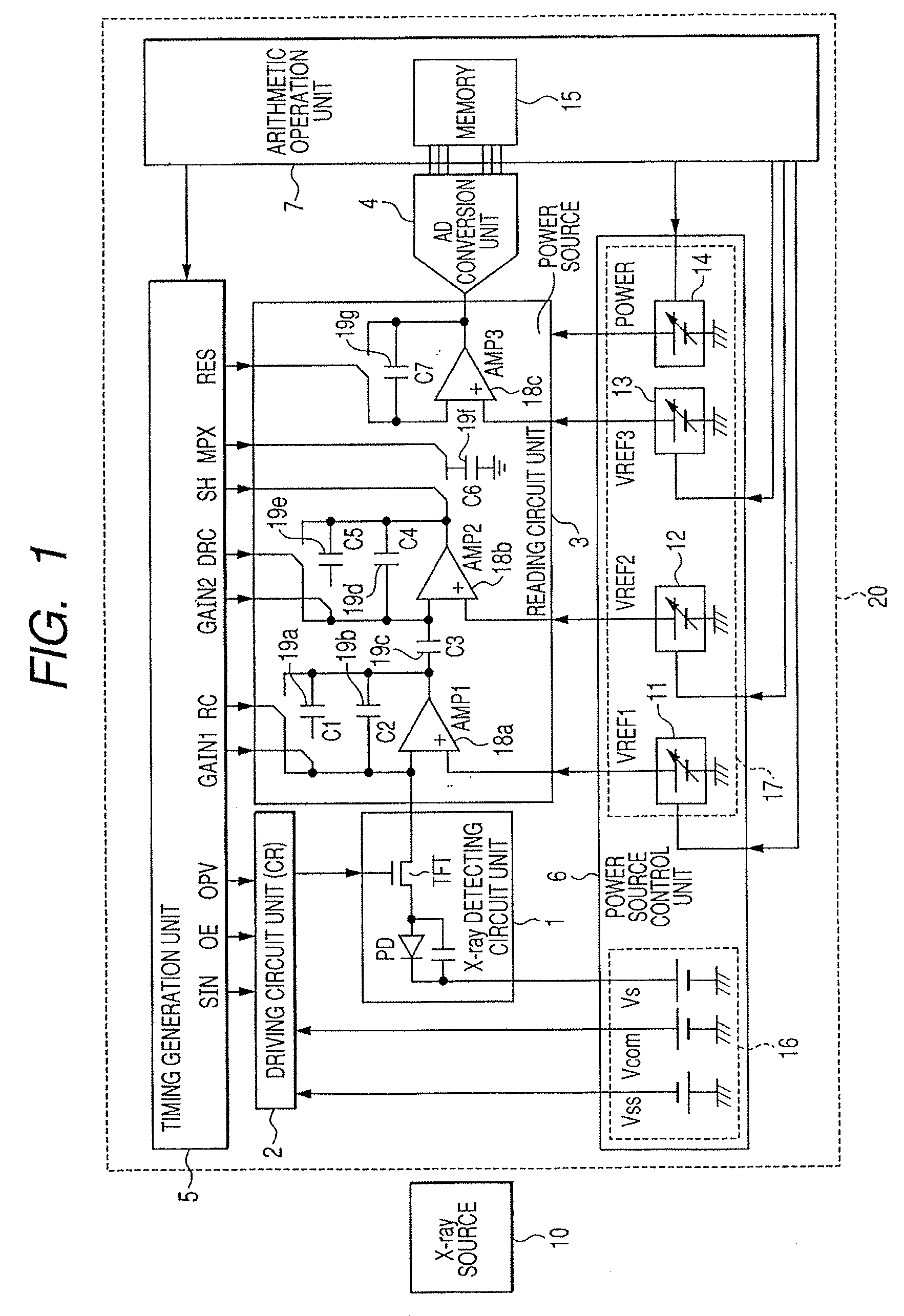Radiation imaging apparatus, radiation imaging system, and program
a radiation imaging and program technology, applied in the direction of x/gamma/cosmic radiation measurement, instruments, radiography controlled devices, etc., can solve the problems of reducing the frame rate of normal drive, affecting the sensitivity of fpd, delay and waveform distortion of scanning-line driving signals, etc., to achieve accurate, high-s/n-ratio x-ray radiographic images and excellent images.
- Summary
- Abstract
- Description
- Claims
- Application Information
AI Technical Summary
Benefits of technology
Problems solved by technology
Method used
Image
Examples
embodiment 1
[0035] (Embodiment 1)
[0036]FIG. 1 is a schematic block diagram illustrating an X-ray imaging system according to Embodiment 1 of the present invention. The X-ray imaging system is configured of an X-ray source 10 for irradiating X-rays onto a subject, an X-ray imaging apparatus 20 for picking up X-rays that have passed through (or that have been reflected by) a subject, and an unillustrated control unit for controlling the drive of the X-ray source 10 and the X-ray imaging apparatus 20.
[0037] In the X-ray imaging apparatus 20, Reference Numeral 1 denotes an X-ray detecting circuit unit for detecting X-rays from a subject. The X-ray detecting circuit unit 1 is configured of a plurality of pixels, juxtaposed in a two-dimensional array fashion, that are each made up of an X-ray detecting element (conversion element) and a switching element for selecting the X-ray detecting element. In Embodiment 1, the X-ray detecting element has a photoelectric conversion element, and a thin-film tra...
embodiment 2
[0082] (Embodiment 2)
[0083] In the present embodiment, a case will be explained in which, in the X-ray imaging apparatus in FIG. 1, VREF1 of the variable power source 11 is changed instead of VREF2 and VREF3. In other words, the arithmetic operation unit 7 changes VREF1 such that the maximal value or the minimal value, of the output, in the irradiation period and the maximal value or the minimal value, of the output, in the non-irradiation period fall within the dynamic ranges of the reading circuit unit 3 and the Analogue-Digital conversion unit 4.
[0084] In the case of the configuration illustrated in FIG. 1, the reference electric potential VREF1 is the output, of the AMP 18a, illustrated in FIG. 3; however, as illustrated associated with the AMP 18c, the last-stage output level at dark is not a function of VREF1. For example, in the case of the moving image radiographing mode, it is required to decrease the X-ray quantity in view of reduction of patient exposure; therefore, in o...
embodiment 3
[0090] (Embodiment 3)
[0091] In the present embodiment, in the X-ray imaging apparatus in FIG. 1, the minimal value of the output at dark and the maximal value of the output at light are each made to be a function of radiographing parameters that configure the radiographing condition. The minimal value of the output at dark and the maximal value of the output at light, which have been made to be functions, are stored in the memory 15 in the arithmetic operation unit 7. Subsequently, the arithmetic operation unit 7 changes the reference electric potentials such that the maximal value of the output at light and the maximal value of the output at light, which have been made to be functions, fall within the dynamic ranges of the reading circuit unit 3 and the Analogue-Digital conversion unit 4.
[0092] The output at light (X-ray output) in the X-ray irradiation period and the output at dark in the X-ray non-irradiation period are functions of the radiographing parameters. For example, the...
PUM
 Login to View More
Login to View More Abstract
Description
Claims
Application Information
 Login to View More
Login to View More - R&D
- Intellectual Property
- Life Sciences
- Materials
- Tech Scout
- Unparalleled Data Quality
- Higher Quality Content
- 60% Fewer Hallucinations
Browse by: Latest US Patents, China's latest patents, Technical Efficacy Thesaurus, Application Domain, Technology Topic, Popular Technical Reports.
© 2025 PatSnap. All rights reserved.Legal|Privacy policy|Modern Slavery Act Transparency Statement|Sitemap|About US| Contact US: help@patsnap.com



